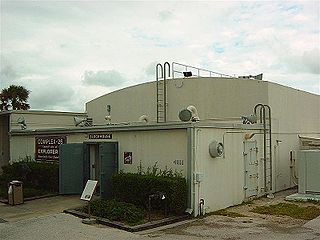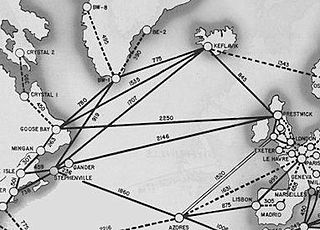Related Research Articles
The SM-65 Atlas was the first operational intercontinental ballistic missile (ICBM) developed by the United States and the first member of the Atlas rocket family. It was built for the U.S. Air Force by the Convair Division of General Dynamics at an assembly plant located in Kearny Mesa, San Diego). Atlas became operational as an ICBM in October 1959 and was quickly obsoleted by new development, being retired as a missile by 1965. The Atlas required extremely long preparation times which made it unsuitable for a quick launch ICBM. However, this was not a requirement for planned space launches, and so Atlas-derived launch vehicles served a long history as space launchers.

Vandenberg Air Force Base is a United States Air Force Base located 9.2 miles (14.8 km) northwest of Lompoc, California. The installation falls under the jurisdiction of the 30th Space Wing, Air Force Space Command (AFSPC).

The Martin Marietta SM-68A/HGM-25A Titan I was the United States' first multistage intercontinental ballistic missile (ICBM), in use from 1959 until 1962. Though the SM-68A was operational for only three years, it spawned numerous follow-on models that were a part of the US arsenal and space launch capability. The Titan I was unique among the Titan models in that it used liquid oxygen and RP-1 as propellants. All subsequent versions used storable propellants instead.

Cape Canaveral Air Force Station (CCAFS) is an installation of the United States Air Force Space Command's 45th Space Wing.

The Minuteman Missile National Historic Site was established in 1999 to illustrate the history and significance of the Cold War, the arms race, and intercontinental ballistic missile (ICBM) development. This National Historic Site preserves the last remaining Minuteman II ICBM system in the United States. 450 of the newer Minuteman III missiles are still on active duty at Malmstrom AFB, Montana, Minot AFB, North Dakota, and F. E. Warren AFB, Wyoming.

The United States Air Force's 10th Space Warning Squadron, is a missile warning unit located at Cavalier AFS, North Dakota.

Cape Canaveral Air Force Station Space Launch Complex 17 (SLC-17), previously designated Launch Complex 17 (LC-17), was a launch site at Cape Canaveral Air Force Station, Florida used for Thor and Delta rocket launches between 1958 and 2011.

Launch Complex 26 (LC-26) is a deactivated launch site at Cape Canaveral Air Force Station, Florida. LC-26 consisted of two pads, A and B. Pad A was used for the Jupiter-C and Juno I rockets, and was the launch site for Explorer 1, the United States' first satellite, in 1958. Pad B was used for Juno II. Jupiter IRBMs were launched from both pads.

The United States Air Force 381st Training Group at Vandenberg Air Force Base, California provides training for the United States Air Force's space forces, intercontinental ballistic missile forces, and missile maintenance forces. This Air Education and Training Command (AETC) organization is a tenant unit located on an 80-acre (32 ha) site at Vandenberg. The group was activated in the fall of 1994, when it replaced a provisional group as missile training activities at Vandenberg were transferred to AETC.

The 30th Space Wing is an air force wing forming a subordinate unit of the Fourteenth Air Force of the Air Force Space Command of the United States Air Force. The 30th Space Wing is based at Vandenberg Air Force Base, California.

The Air Force Space and Missile Museum is located at Launch Complex 26 at Cape Canaveral Air Force Station, Florida. It includes artifacts from the early American space program and includes an outdoor rocket garden displaying rockets, missiles and space-related equipment chronicling the US Air Force.

Launch Complex 16 (LC-16) at Cape Canaveral Air Force Station, Florida is a launch complex built for use by LGM-25 Titan missiles, and later used for NASA operations before being transferred back to the US military and used for tests of MGM-31 Pershing missiles. Six Titan I missiles were launched from the complex between December 1959 and May 1960. These were followed by seven Titan II missiles, starting with the type's maiden flight on March 16, 1962. The last Titan II launch from LC-16 was conducted on May 29, 1963.

Launch Complex 31 (LC-31) is a former launch complex at Cape Canaveral Air Force Station, Florida.

The 30th Operations Group is an operational component of the United States Air Force 30th Space Wing, stationed at Vandenberg Air Force Base, California.

The 549th Strategic Missile Squadron is an inactive United States Air Force unit. It was last assigned to the 385th Strategic Aerospace Wing, stationed at Offut AFB, Nebraska.
Vandenberg Air Force Base Launch Facility 10 (LC-10) is a US Air Force Intercontinental ballistic missile launch facility on Vandenberg AFB, California, USA. It is a launch site for the land-based LGM-30 Minuteman ICBMs.
Launch Complex 32 (LC-32) is a former launch complex at Cape Canaveral Air Force Station, Florida.
Launch Complex 25 (LC-25) was a four-pad launch site at Cape Canaveral Air Force Station, Florida built for test flights of the US Navy's submarine-launched ballistic missiles Polaris, Poseidon and Trident from 1958–1979.

Presque Isle Air Force Base was a military installation of the United States Air Force in Maine. In the late 1950s and early 1960s it became a base for Strategic Air Command.

Cape Canveral Air Force Station Launch Complex 45 is a former launch complex created to launch the Roland missile. However, it was never used prior to its destruction, and Launch Complex 46 is now in its location.
References
- ↑ "Launch Complex 30". Air Force Space and Missile Museum. Retrieved 14 March 2016.
| This space- or spaceflight-related article is a stub. You can help Wikipedia by expanding it. |